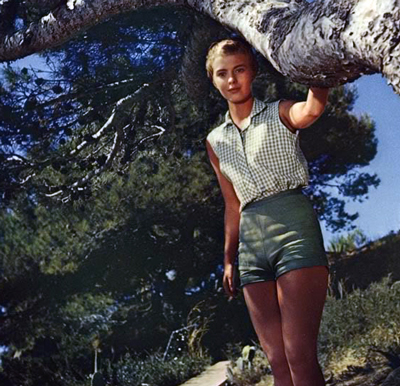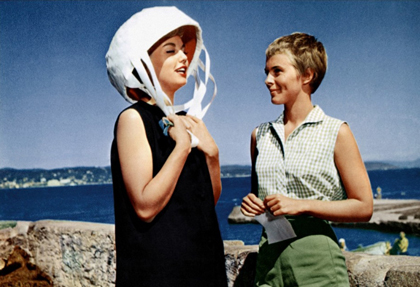
 |
|
|
|
French film critics must have flipped when one of their favorite American auteurs Otto Preminger took on Françoise Sagan's confessional-declaratory novel Bonjour Tristesse. The 1958 potboiler is a romantic tragedy that toys with ideas of incest. Many of the French locations are real but David Niven and Deborah Kerr seem very English as a wealthy French womanizer and an opinionated Paris designer; Preminger discovery Jean Seberg is the daughter growing up with what at the time were considered an odd set of decadent values. Beautifully shot by cinematographer Georges Périnal and quite impressive in CinemaScope, Bonjour Tristesse is an awkward film with a loyal band of devotees. 
The story attempts to capture the mindset of a Parisian girl with all the advantages and little incentive to do anything but enjoy the nightlife and have a good time. Neither Cecile (Jean Seberg) nor her playboy father Raymond (David Niven) cares that she's flunked out of school. Atypically sad, Cecile ponders events of the previous summer in the South of France: in the past, father and daughter spend the summer making merry at a seaside chateau. Elsa (Mylène Demongeot) is Raymond's playmate for the vacation time, until old flame fashion designer Anne Larson (Deborah Kerr) shows up. Soon Raymond and Anne are engaged, and the fun stops: the bossy woman cuts off Cecile's flirtation with neighbor boy Philippe (Geoffrey Horne) and insists that she bear down on her studies. Cecile is already far too solicitous about her father's affairs, and is not the type to be manipulated by anybody. Bonjour Tristesse came out at a time when Otto Preminger was a star in Europe but a perceived maker of flops in his own country. The terrific Anatomy of a Murder would cause his currency with the critics to rise again, but in 1957 Preminger was considered a promising talent who made Laura and then receded into murky melodramas and ill-conceived pictures like The Court-Martial of Billy Mitchell and Saint Joan. The Joan of Arc picture was criticized for Preminger's casting of American amateur Jean Seberg, and the general critical sniping continued in this follow-up. Tristesse works perhaps too hard to evoke a European feel. Most of its dramatic effects are obvious and even when the production values impress -- all those beautiful South-of-France beach locations -- the show has a feeling of 'strictly controlled spontaneity'. Cecile and Raymond, very close but not incestuous in any literal sense of the word, spend a leisurely summer at a seaside villa pursuing suntans, swimming and taking in the night life while Raymond beds his latest casual girlfriend, Elsa. The moral inference is that Raymond is a bad influence on 17 year-old Cecile, what with all the sun and sex and nights spent drinking, dancing and gambling in town. The pair has housemaids to wait on them, beautiful wardrobes and fancy cars to drive; Cecile leads boys on and then drops them at a whim. She is not exactly the image of propriety, but she's certainly her own person. Then the Deborah Kerr character Anne Larson comes into the story. Niven is completely smitten with her. Exactly what their earlier relationship was, or how the mature Anne can possibly compete with his younger playgirls, is unclear. Raymond ditches his present plaything to chase after the always-formal Anne. As soon as this intruder has her hooks into him, she lowers the boom on Cecile, who all of a sudden must be policed to see that she studies. With puritanical righteousness Anne forbids Cecile to see a young neighbor, the wholesome Philippe (Geoffrey Horne, perhaps working off his Columbia contract from Bridge on the River Kwai?). The normally lax Raymond caves in to Anne's wishes and Cecile acts as if her dad had been taken away from her. He's once again treating her as a child. So far as Cecile is concerned, it's Anne that needs to be gotten rid of. 
Part of the film's loyal following can be attributed to the Françoise Sagan novel. To adapt it Preminger hired the revered playwright and screenwriter Arthur Laurents (West Side Story, Rope, Anastasia). Bonjour Tristesse suffers for the same reasons that any racy French novel would if made to conform to 1950s Hollywood standards. If there was previously any bite to the theme of incest or anything untoward about the sleeping arrangements at villa Raymond, it's now gone. Elsa has her own room; to pre-empt what should be an active sex relationship with Raymond, she's been given a severe sunburn. The closest thing to an orgy is a line of drunken dancers down at the resort town. Everyone keeps their clothes on and the conversation above board. The speeches that Laurents finds for his characters could very well fit into one of those Vincente Minnelli '50s dramas that now seem so dated. Even more obvious is that no matter how good the acting and how authentic the locations, none of it seems French. Kerr and Niven are excellent actors and have an advantage over Seberg in that their dubbing (the movie looks to be largely post-dubbed) is excellent. By contrast, the pert Mylène Demongeot and Walter Chiari's real accents sound like speech impediments. The story is specific about this being a carefree, morally lax French summer, but the whole enterprise seems chaperoned. Those French critics can be unpredictable. 1 Jean Seberg is visually interesting as Cecile, a pampered young girl perfectly content to live La Dolce Vita and disinterested in anything more complicated. She was again the target of critics that considered her Preminger's Folly. They didn't let up until she played Peter Sellers' standard helpless object of romance in the next year's The Mouse that Roared. Preminger's fling at a 'European' cinema experience comes complete with a dreamy B&W flashback structure, presenting Cecile as a jaded Parisienne pursued by attractive men in fancy cars, but lost in dreamy memories. The main tale is thereby allowed to amble along without a set direction (not a bad thing). To add to the atmosphere, the authentic existentialist entertainer Juliette Gréco sings the downbeat title tune in a nightclub. The Georges Auric song, purred by an upcoming star (also being groomed by a different big Hollywood hotshot) almost comes across as product placement. The flavor of English actors suppressing a Gallic feel is confirmed with David Oxley (The Hound of the Baskervilles) as 'Jacques', and the veddy English Roland Culver and Jean Kent as Mr. and Mrs. Lombard. Martita Hunt as Philippe's card-playing mother is so good, we don't care that she's not French. Ms. Hunt made her mark in fine movies from Great Expectations (as Miss Havisham) to The Brides of Dracula. 
Goateed choreographer Tutte Lemkow can be seen dancing in the nightclub party sequence; his interesting looks must have served him well in auditions because he shows up in many Columbia pictures around this time, playing a Greek peasant in The Guns of Navarone, for example. As a choreographer Lemkow later engineered the complex bal des vampires in Roman Polanski's The Fearless Vampire Killers. The Twilight Time Blu-ray of Bonjour Tristesse will delight fans of this upscale show, which regained a place of honor as Otto Preminger's critical stock rose in the 1960s. The sharp image and intense color are a big improvement over the already good older DVD. The B&W sequences are just as impressive, perhaps because modern transfer capabilities allow them to show up in true black and white. The interesting introduction to the summery past of Cecile's memories sees little sections of the B&W screen turning to color and then receding, before finally committing to a dissolve to full color. Saul Bass's arresting graphic title sequence features the 'sad face' Tristesse logo seen on the box top. I'd have to say that someone must have 'borrowed' the look for a Barbra Streisand record album and TV show a few years later. The audio track is monaural. I'm pretty certain that it was always so; not too many CinemaScope movies were still released in multi-track stereo by this year. Twilight Time showcases George Auric's evocative compositions on its customary Isolated Music score track. Also of interest is a trailer that begins with an interview with author Sagan, who looks a little bit like Jean Seberg. Even in this promotional format Sagan tries to duck some of the questions. After a B&W opening, the trailer finishes in color as a standard Coming Attractions reel. As we've come to expect, Julie Kirgo's liner notes compress a lot of good ideas about Tristesse, Otto Preminger and Jean Seberg into a trim insert pamphlet, offering the film as an inspiration for the French New Wave. Original prints were in Technicolor and CinemaScope. By 1958 'improved' lenses were supposedly in service, with less distortion and a flatter field. But many close-ups in Tristesse show signs of the dreaded CinemaScope Mumps. Oddball 'scope visuals in many English and European films credited with the process prompt me to theorize that some foreign cameramen weren't properly trained on the use of the lens. Either than, or Bausch & Lomb/ C'Scope dumped older lenses in Europe for lower rentals, and the films made with them ended up with the kinds of flaws seen in 1954 and 1955. The B&W frame grab above was swiped from the web so I can't vouch for its accuracy, but it would seem to exhibit this slight horizontal 'mumps' squash effect -- Jean Seberg's face just isn't that wide.
On a scale of Excellent, Good, Fair, and Poor,
Bonjour Tristesse rates:
Footnotes:
1. Slight adjustment: Anne Larson (Kerr) may be intended to be English. Under the circumstances, it's hard to tell, unless I missed a direct reference.
Reviews on the Savant main site have additional credits information and are often updated and annotated with reader input and graphics. Also, don't forget the 2011 Savant Wish List. T'was Ever Thus.
Review Staff | About DVD Talk | Newsletter Subscribe | Join DVD Talk Forum |
| ||||||||||||||||||